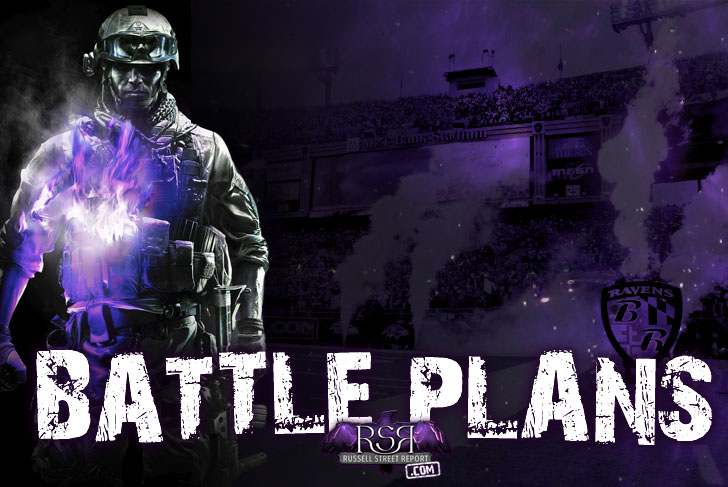Offense
1. 3×1 Stack Alignments
In last week’s game against the Browns, the Ravens started the game with a very aggressive approach, dialing up a combination of three-receiver looks on most of their snaps. The general combo included receivers Kamar Aiken, Marlon Brown, and Darren Waller. Waller would be in the slot while Aiken and Brown worked from the outside.
On a couple of occasions, they brought in a fourth receiver and showed a 3×1 formation, with the X (receiver aligned furthest from the TE) being Aiken. Aiken was targeted on those plays because he was able to draw single coverage. However, the Ravens didn’t go back to the alignment after the early stages of the first half.
The wrinkle in Trestman’s 3×1 scheme is that the three receivers to the opposite side were in a bunch set, as opposed to simple trips. In the bunch, the receivers are a little more staggered in their stances so it’s harder to tell where the receivers are going to release. Depending on which routes are run, there can be an opportunity to create separation through natural picks, especially against man coverage.
When 49ers defensive coordinator Eric Mangini shows man coverage, Trestman needs to counter with the 3×1 bunch look. At this point, the receivers can’t get open on their own, so he needs to be creative with his designs and formations to give them a better chance.
2. Motioning and Moving Ross and Givens
When the Ravens do go to their 3×1 sets, Chris Givens and/or Jeremy Ross should see the field more. The duo didn’t see the field enough despite clearly bringing speed and change-of-direction elements that the other receivers don’t have.
Givens was able to get separation against Joe Haden downfield (although he and Joe Flacco weren’t able to connect on their attempts) and Ross showed the ability to gain yards in the open field.
The Ravens should try to move around both players so they can use their speed to create mismatch opportunities from the inside-out. In the case of Givens, even though he is better suited to run patterns outside the numbers, it would make sense to let him work from the slot to expand his route tree.
From the slot, Givens can continue to run deep patterns, but he’d have more space to operate. The 49ers play a lot of zone, so he would be able to split the safeties on the post or he can run a deep clear route for an underneath target.
Ross is someone the coaches need to use in space. But he is also adept running routes from the slot as well. With Waller being out, Ross can take up the role as the “motion” guy to run quick-hitting inside routes. By going in motion, Ross can get a free release every time and give Flacco an underneath safety value.
3. Soften the Middle
Not surprisingly, Football Outsiders’ DVOA (Defense-adjusted Value Over Average) places the 49ers dead last when it comes to defending passes over the middle. The Giants put on a clinic against the San Francisco backers, exclusively working the ball to Shane Vereen and tight end Larry Donnell on the final drive of the game.
NaVorro Bowman’s return has helped in the run game, but he hasn’t looked as agile in pass coverage as he did before the ACL tear. And Michael Wilhoite is too stiff to keep up with more athletic receivers in space.
The Ravens don’t have anyone close to Vereen in their arsenal. The closest would be Justin Forsett. But even if Forsett ends up playing (he’s a game-time decision), there is no telling how sharp his cuts will be on a bum ankle.
Rookie Buck Allen is a nifty route runner in his own right, and has shown flashes (between college and the preseason) that he can be really good in the passing game. He should be used in that role against the San Fran inside and outside LBs.
Trestman needs to diversify the routes the tailbacks and fullback Kyle Juszczyk run. There should be a mix of angle and wheel routes to go with the typical flares and out patterns the backs have been running. And he should also get the tight ends involved in running routes from the backfield.
Defense
1. Tipping Point
When it comes to bringing heat on the quarterback, the Ravens brought the blitz early and often against the Browns. So no one can say they didn’t try to bring extra rushers to ratchet up the pressures. But they were over-aggressive and predictable with their rush patterns.
Here’s a telling quote from Joe Thomas on the Ravens’ attack: “They were blitzing the safety and trying to do whatever they could to take away the run game. So after the first quarter, we said, ‘Screw it. We’re going to play with three wide receivers, and if they’re going to try and blitz the run game, we’re just going to make the throws on the edges and take the ball down field.”
While the Browns adjusted in their early down approach, the Ravens couldn’t keep up. They kept bringing the same telegraphed slot corner blitz (using Terrence Brooks) from the strong side, or they would bring their inside backers on the cross blitz up the middle. Either way, the Browns had a bead on the combinations and they picked up the blitz in most situations.
Dean Pees has to make two adjustments against the 49ers.
One, his blitzers have to be more disciplined before the snap. They shouldn’t tip off their blitz movement so early. If anything, they should be in a static stance and move after the snap through a delayed motion.
In fact, one of the pressures that worked perfectly came from a two-man game between Timmy Jernigan and C.J. Mosley. Jernigan stunted inside while Mosley (on delayed blitz) looped around from the outside, through the outside gap. This type of coordinated rush has worked for the front in the past, especially when the rush comes on a delayed move.
Two, Pees needs to stop selling out on the blitz. He can run more 4-man and 5-man pressures from different angles and launch points while keeping six or seven players back in coverage. He has to use more zone-blitz combinations.
In fact, the Steelers gave the blueprint for attacking the 49ers using this very concept a couple of weeks ago. They were creative in rushing Ryan Shazier from the outside (he normally plays inside), and although they would show a heavy blitz look at times, they wouldn’t typically bring more than four or five players on the rush.
Pees has to be more creative with his rush or else even Colin Kaepernick will be able to spread it out and sling the ball all over the field like Josh McCown did last Sunday.
2. Pre-Snap Motion
Another area where the defense has struggled is keeping up with misdirection. Whether it’s boot action, play-action (through the jet sweep), or late motion, offenses have been a step ahead of the plodding Ravens defenders.
The 49ers use a wide variance of pre-snap motion and play-fakes to set up screens to their receivers on the edges. They’ll also mix in some misdirection plays, setting up tosses or sweep pitches to their backs.
The defense needs to be prepared for all of this action and maintain their assignments. If the defense is caught over-pursuing or caught out of position entirely, the 9ers will have the chance to capitalize in a big way.
3. The Belichick Coverage Formula
In the past, whenever the Ravens went against Bill Belichick’s defenses, they would see a common coverage type.
Belichick aimed to take away Torrey Smith’s deep play ability by double-teaming him, keeping a safety over the top at all times. When it came to defending Anquan Boldin, Belichick would use his best corner to shadow without sacrificing his safeties. The most memorable instance came during the 2013 AFC Championship when Boldin had to deal with the physical Aquib Talib, who held Boldin down until he went out of the game with a hamstring injury.
Now, this formula didn’t always work against Smith and Boldin, but it’s a pretty solid strategy. As good as Boldin is, he won’t beat you deep. And Smith already runs a limited route tree, so confining him to underneath routes is a win for the defense.
The Ravens should duplicate the approach against San Fran using Jimmy Smith to shadow Boldin, and relying on bracket coverage to take away Smith. With Smith, the corner (whether it’s Kyle Arrington or any of the newly acquired corners) has to hit and press him at the line to stymie his release.
One-on-One Matchup to Watch
Jimmy Smith versus Anquan Boldin
Continuing the discussion of Smith against Boldin, this has the potential to be a rugged street fight. Boldin doesn’t get much separation, but he is still a crafty route runner who uses his body to position defenders away from the ball. He’ll win on most inside routes and jump balls. Meanwhile, Smith has the size and strength to play Boldin straight up. He’ll need to play his most physical game of the season to counter Boldin’s size and strength.










